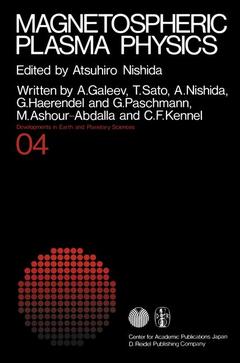Magnetospheric Plasma Physics, Softcover reprint of the original 1st ed. 1982 Developments in Earth and Planetary Sciences Series, Vol. 4
Langue : Anglais
Coordonnateur : Nishida A.

Studies related to the earth and planets along with their surroundings are of great concern for modern scientists. Global geodynamics as represented by plate tectonics has now become one of the most powerful tools by which we can study the causes of earthquakes, volcanic eruptions, mountain formation and the like. Various missions sent out to space, manned or of the moon, Mars, Venus and unmanned, brought out geoscientific features other planets. Earthquake prediction that was the business of astrologers and fortune-tellers some twenty years ago, has now grown up to be an important science. A number of destructive earthquakes were successfully forecast in the People's Republic of China. In the light of the above-mentioned and other accomplishments in geosciences, we feel that it is a good thing to publish a series of monographs which review selected topics of earth and planetary sciences. We are of course well aware of the fact that similar monographs have been and will be published from overseas publishers. The series, which we plan to publish, will therefore stress Japanese work. But we hope that the series will also include review articles by distinguished overseas authors.
1 Origin of Magnetospheric Plasma.- 1 Introduction.- 2 Atmospheric Source of Magnetospheric Plasma.- 3 Temperature of the Atmospheric Plasma.- 4 Transport and Heating Effects of Photoelectrons.- 5 Plasma from Jupiter’s Satellite Io.- 6 Entry of Solar-Wind Plasma into the Plasma Sheet.- References.- 2 Interaction of the Solar Wind with the Dayside Magnetosphere.- 1 Solar Wind Flow around the Magnetopause.- 1.1 Shape of the Magnetopause.- 1.2 Flow around the Magnetopause.- 1.3 Plasma Depletion Near the Stagnation Point.- 1.4 Structure of the Magnetopause.- 2 The Bow Shock.- 2.1 Collisionless Shocks.- 2.2 Observed Bow Shock Structure.- 2.3 Upstream Phenomena.- 3 The Boundary Layer.- 3.1 Boundary Layer Morphology.- 3.2 Plasma Blobs, Vortex Flows and Geomagnetic Pulsations.- 3.3 Coupling to the Ionosphere.- 3.4 Transfer of Mass, Momentum and Energy.- 4 Evidence for Reconnection at the Magnetopause.- 4.1 Indirect Evidence.- 4.2 In situ Observations.- 4.3 Flux Transfer Events.- 5 Microprocesses Related to Reconnection.- 5.1 Macroscopic Constraints.- 5.2 Relevant Instabilities.- 5.3 Wave Observations.- 5.4 Origin and Maintenance of Reconnection.- References.- 3 Magnetospheric Tail Dynamics.- 1 Introduction: Model of the Equilibrium Neutral Sheet.- 2 Microinstabilities of the Quiet Magnetospheric Tail.- 2.1 The Lower-Hybrid-Drift Instability of the Plasma Sheet and the Anomalous Resistivity.- 2.2 Pitch Angle Scattering Modulation by Plasma Convection.- 3 Tearing Instability of the Magnetospheric Tail as the Mechanism for Substorms.- 3.1 Energetics of Substorms.- 3.2 Linear Stability Analysis of the Plane Neutral Sheet.- 3.3 Marginal Magnetotail Stability.- 3.4 Effect of the Electrical Coupling with the Ionosphere.- 3.5 Pitch-Angle Scattering Destabilizing Effect.- 4 Magnetospheric Bursts of Energetic Particles.- 4.1 Explosive Growth of the Tearing Mode at the Nonlinear Stage.- 4.2 Magnetospheric Bursts of Energetic Particles.- 5 Macroscopic Consequences of the Ion Tearing Mode Instability in the Magnetotail.- References.- Appendix: Tearing Mode Stabilization in a Two-Dimensional Plasma Sheet Configuration with Magnetized Electrons.- 4 Auroral Physics.- 1 Introduction.- 2 Primary Energy Sources of Auroras.- 2.1 Sources of Field-Aligned Currents.- 2.2 Sources of Mechanical Energy.- 3 Double Layers: Acceleration Mechanism.- 3.1 Ion Acoustic Double Layers.- 3.2 Steady-State Theory.- 3.3 Some Remarks on Boundary Conditions.- 4 Magnetosphere-Ionosphere Coupling: Auroral Arcs.- 4.1 Basic Relations.- 4.2 Feedback Instability: Formation of Auroral Arcs.- 5 Auroral Kilometric Radiation.- 6 Closing Remarks.- References.- 5 Electrostatic Waves and the Strong Diffusion of Magnetospheric Electrons.- Abstract.- 1 Introduction.- 2 Outline.- 3 Two Problems of Coupled Spatial Transport and Pitch Angle Diffusion.- 3.1 Radiation Belt Diffusion and Loss.- 3.2 The Diffuse Aurora.- 4 General Properties of Electrostatic Waves in a Magnetized Plasma.- 4.1 Linear Dispersion Relation.- 4.2 Separable Distribution Functions.- 4.3 Electrostatic Waves in a Zero Temperature Plasma.- 4.4 Bernstein Modes.- 4.5 Bernstein Modes in a Two-Component Plasma.- 4.6 Cyclotron Harmonic Instabilities.- 4.7 General Conditions for Instability.- 4.8 Anisotropy Instabilities.- 4.9 Summary.- 5 Free Energy Sources for Magnetospheric Electron Cyclotron Harmonic Instabilities.- 5.1 Introduction.- 5.2 Perpendicular Free Energy Sources.- 5.3 Parallel Free Energy Sources.- 5.4 Power Law Energy Distributions.- 5.5 Relativistic Bernstein Mode Instabilities.- 5.6 Discussion.- 6 A Parametric Study of Convective Loss Cone Instabilities.- 6.1 Introduction.- 6.2 Possibility of Nonconvective Instability.- 6.3 Dependence of Nonconvective Loss Cone Instability upon Cold Electrons.- 6.4 Location of Growing Modes in K-Space.- 6.5 Discussion.- 7 Observations of Magnetospheric VLF Electric Fields.- 7.1 Introduction.- 7.2 OGO-5 Observations.- 7.3 Types of Magnetospheric Electron Cyclotron Harmonic Emission.- 7.4 Classification and Spatial Distribution of Cyclotron Harmonic Emissions.- 7.5 Discussion.- 7.6 Electrostatic Waves in the Jovian Magnetosphere.- 8 Comparisons between Linear Theory and Observation.- 8.1 Introduction.- 8.2 Dependence upon Cold Electrons.- 8.3 Dependence upon Hot Electron Free Energy Source.- 8.4 Summary.- 9 Some Nonlinear Considerations.- 9.1 Introduction.- 9.2 General Properties of Quasilinear Diffusion.- 9.3 Saturation.- 10 Concluding Remarks.- References.
Date de parution : 10-2011
Ouvrage de 348 p.
15.5x23.5 cm
Disponible chez l'éditeur (délai d'approvisionnement : 15 jours).
Prix indicatif 210,99 €
Ajouter au panierThème de Magnetospheric Plasma Physics :
Mots-clés :
© 2024 LAVOISIER S.A.S.
